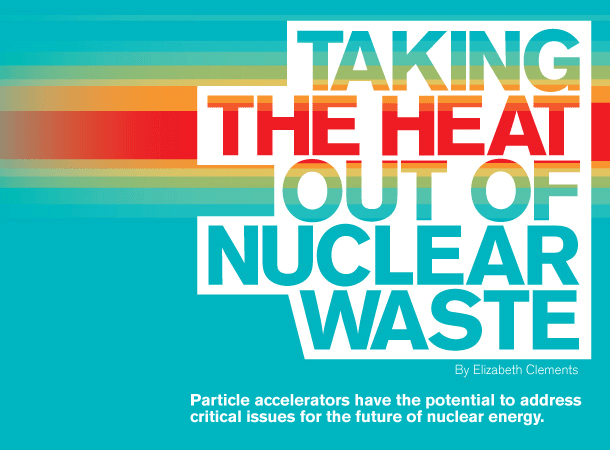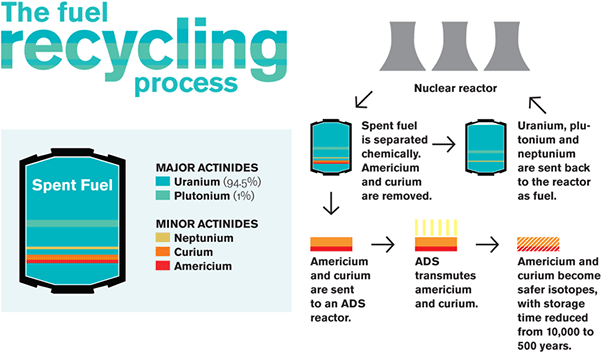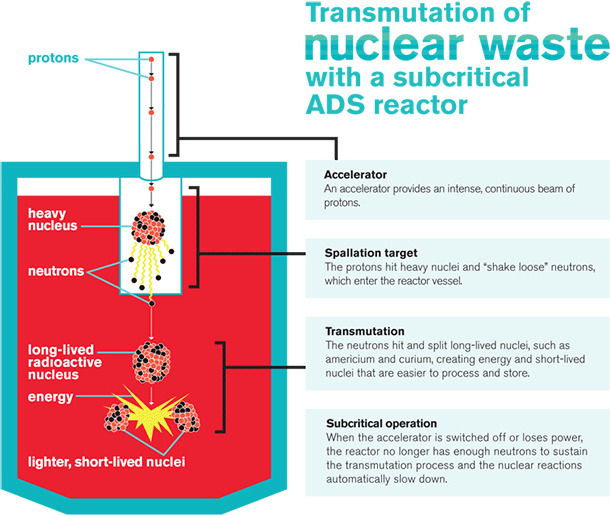
Taking the heat out of nuclear waste
Particle accelerators have the potential to address critical issues for them future of nuclear energy
by Elizabeth Clements
Picture a football field covered seven yards deep in metal containers full of used nuclear fuel. That's the amount of radioactive wasteroughly 65,200 metric tonsthat nuclear power plants in the United States produced in the last four decades.
According to the Nuclear Energy Institute, a policy organization for the nuclear technologies industry, the US nuclear industry generates 2000-plus metric tons of nuclear waste every year. Given the nation's energy appetite, this rate of accumulation will not decrease any time soon. Yet today the only potential long-term storage option for nuclear waste in the US would be an underground geological repository, which so far doesn't exist.
A particle accelerator may contribute to an alternative solution.
A powerful enough accelerator could generate a beam of particles to help transform spent nuclear fuel into a re-useable form. It could reduce the time required for long-term geological storage from 300,000 years to 500 years. And it could use an abundant natural resource, thorium, as a safer, cleaner, more proliferation-resistant fuel for energy production in nuclear reactors.
Recent advances in accelerator technology could make this concept, called Accelerator Driven Systems or ADS, a reality in the relatively near future. While countries in Asia and Europe are actively pursuing its applications and building demonstration facilities, however, the United States does not have an active ADS program. Accelerator and nuclear physicists and engineers are pushing for this to change.
"A lot of technologies, including ADS, have been proposed to try to resolve the [nuclear] waste issue," says Albert Machiels, a technical executive at the Electric Power Research Institute, a non-profit company that conducts research and development for all things related to electricity.
"To demonstrate its viability at a scale necessary to make a significant impact will require sustained R&D for long periods of time," he says.
Protons for safer fission
At the heart of most nuclear reactors is a process called fission in which heavy atoms split into lighter ones, releasing tremendous amounts of energy.
Uranium, the fuel source in the majority of nuclear power plants, naturally undergoes fission all the time, emitting neutrons as it splits. Those neutrons hit other uranium atoms, causing them to split and release more neutrons, and so on in an escalating chain reaction. If this continues, the reactor is said to be "critical," and the reaction continues until the uranium runs out. Most nuclear reactors use moderators to slow down emitted neutrons and control the fission process. The energy released by all this atom-splitting generates steam, which spins a turbine to drive a generator and produce electricity.
In ADS, however, the road to fission starts with a linear accelerator.
Although the details of proposed designs differ, the basic concept accelerates a beam of protons to 1-2 billion electronvolts of energy and slams them into a heavy-metal target in the core of a reactor. Each proton that hits the target generates about 30 neutrons, which drive the fission process. Turn off the proton beam, and the process stops. Such a reactor, one that does not sustain a chain reaction on its own, is said to be "subcritical."
An ADS system could use this subcritical process to transmute the most troublesome long-lived components in radioactive waste into safer forms with shorter lifetimes.
Breakthrough in accelerator technology
In the 1990s and early 2000s, several studies in the US and abroad evaluated the potential for using ADS to treat highly radioactive components of nuclear waste by transmuting long-lived radioactive isotopes to safer ones with much shorter half-lives. However, at the time ADS was expensive and at an early stage of development. The studies found the technology had not been adequately demonstrated, and as a result the small existing R&D program was eventually terminated.
For an accelerator to treat nuclear waste effectively, it must work continuously. In accelerator-speak, that means it must generate particles in a continuous wave, rather than in discrete bunches. At the time the studies took place in the 1990s, linear accelerators had demonstrated that they could produce continuous-wave beams, but the technology wasn't yet reliable enough for use in ADS. In the last decade, however, major advances in accelerator science and technology have allowed scientists to demonstrate that a linear accelerator could reliably produce the continuous-wave beam that ADS requires.
"In the last 10 years, scientists around the world changed the picture by developing superconducting radiofrequency and other technologies that make it practical to create a continuous-wave linear accelerator," says Yousry Gohar, a senior nuclear engineer at Argonne National Laboratory.
Scientists have selected superconducting radiofrequency, or SRF, as the technology of choice for next-generation particle accelerators due to its efficiency and ability to sustain high-power beams of a few megawatts or moreclose to the level of power needed for ADS. Besides supporting fundamental physics research, an accelerator using SRF technology could also open doorways to applications related to nuclear energy.
But why use an accelerator as a dedicated neutron source to transmute nuclear waste in the first place?
"The safest and most efficient reactor process for transmutation would use ADS," says Eric Pitcher, a nuclear engineer at Los Alamos National Laboratory. "Because the reactor operates in a subcritical mode, it is useful for specific applications like burning problematic constituents in used nuclear fuel."
Fuel reprocessing
On average, the uranium fuel that drives a commercial nuclear power plant lasts three years before it stops producing energy efficiently. The plant operator then removes the spent fuel from the reactor and stores it on site. Power plants in some countries reprocess some fuel for reuse in their reactors, but in the United States no nuclear waste is reprocessed.
In 1982, Congress passed legislation creating the Nuclear Waste Fund to establish a waste disposal program. For every kilowatt-hour produced, nuclear power plants contribute one-tenth of a cent to the fund. Since 1983 the fund has collected $35.8 billion and spent $10.8 billion, according to the Nuclear Energy Institute. Yet 30 years later, a disposal program is yet to be established.
Uranium makes up 94.5 percent and plutonium makes up 1 percent of used nuclear fuel. The remaining constituents are the minor actinides, a group of elements comprising neptunium, curium and americium, and other fission products.
"While curium is the most radioactive and hence the most problematic to process," Pitcher says, "americium dominates the radioactivity level in a repository in the 1,000-year time frame, which can limit the amount of high-level waste placed in a repository. The utilities operating today don't want to take recycled fuel that has americium in it. They just want to produce electricity, and the last thing they want to do is to take problematic fuel."
Roughly 10,000 years must pass before the americium decays to the same level of radiotoxicity as the uranium ore used to produce the nuclear fuel in the first place. ADS would transmute americium into short-lived fission products, reducing this time to less than 500 years.
"ADS is well suited to treat the most problematic issue in nuclear wasteamericium and curium," Pitcher says. "ADS will be expensive because you have to build an accelerator. So you want to focus on those constituents that are more difficult to burn in a classical reactor."
One proposed process would chemically extract the plutonium and uranium from nuclear waste and send them back into a nuclear reactor as fuel. Pitcher explains that neptunium can go along with the plutonium and uranium, because those three elements together do not present reprocessing risks. Carrying the neptunium along with the plutonium and uranium, something that no country that reprocesses spent fuel currently does, would leave manageable amounts of americium and curium for ADS transmutation.
"If you isolate the uranium, plutonium and neptunium from the fission products and other actinides in the used fuel," Pitcher says, "you can make new fuel from them and deliver it to a reactor site in the classical way that happens today. While those components are radioactive, you can still manufacture, inspect, and ship the new fuel without exposing workers to significant radiation."
A few ADS reactors would then burn, or transmute, the americium and curium that make the fuel so extremely radioactive.
The US accumulates used nuclear fuel at a rate of 2000 metric tons per year, producing a little over three tons of americium and curium. To transmute that amount into safer isotopes would require operating three ADS reactors in parallel.
Building three linear accelerators would be expensive, currently a few billion dollars. However, their cost pales in comparison to the cost of chemical separation and reprocessing of spent uranium and plutonium, the other essential piece of the fuel recycling process. Pitcher estimates the cost of building a reprocessing plant at between $10 billion and $20 billion, a figure that explains why few such plants exist in the world. France, the United Kingdom, Russia, and India operate reprocessing facilities. Japan will begin operating one in late 2012, and China is developing plans for a facility. None exist in the US, nor are any plans in the works. The cost presents a high threshold for a national nuclear fuel-reprocessing program. However, by removing the most problematic components, ADS does make such an investment more feasible.
And ADS systems have the added bonus of producing energy.
As the americium and curium break down inside an ADS, their splitting atoms would produce energy, for which the world has an insatiable appetite. For the moment, though, most US scientists agree on optimizing the design of ADS for the purpose of transmuting waste and treating energy production as a byproduct that would make the system itself largely energy self-sufficient.
Thor: God of thunder
While US researchers focus on using ADS to treat nuclear waste, other countries around the world are pursuing the technology to produce energy.
Named after the Scandinavian god Thor, the natural element thorium was discovered in the Earth's crust in Norway in 1829. Thorium is widely distributed, three to four times more plentiful than uranium in the Earth's crust.
A beam of protons from an ADS would produce an external source of neutrons to drive a subcritical reactor loaded with thorium, a non-fissile fuel that cannot support a self-sustaining chain reaction. In an accelerator-driven subcritical thorium reactor, neutrons produced by a proton beam hitting a metal target breed uranium and promote its fission. These fission reactions could serve either for power generation or for the transmutation of highly radioactive components of nuclear fuel.
Turning off the accelerator immediately stops the fission reactions.
Because thorium is abundant, produces much shorter-lived waste, and is highly proliferation resistant, a growing number of scientists around the world are pushing to develop it as a potential alternative fuel for nuclear power plants.
India, Norway and Brazil have the world's largest supplies of thorium. All threeIndia most activelyare pursuing programs to use thorium for nuclear energy. China also has an active program, as the Chinese too have a large supply of thorium.
"There is a market for it in developing countries, like India, where concentrations of energy use are sufficiently dense," says Roger Barlow, a physicist at Britain's University of Huddersfield and chairman of the Thorium Energy Amplifier Association.
While US scientists agree on the scientific feasibility of using ADS in a thorium-fueled subcritical reactor, Argonne's Gohar explains that pursuing a US thorium program lacks urgency because the country has plenty of natural uranium. Instead, solving the nation's nuclear waste crisis should remain the highest priority, he says.
"If you look at it from the need point of view, the US has plenty of natural resources, but the country would benefit from using ADS for transmuting minor actinides to get rid of spent nuclear fuel," Gohar says. "We don't have a storage facility right now, and we're not pursuing a storage facility. Transmutation is a good possibility."
A demonstration facility
The proposals exist. The studies have been done, and the reports have been written. What remains is a demonstration facility to determine if ADS can achieve its goals.
Major efforts are under way in Europe, where MYRRHA, the Multipurpose hYbrid Research Reactor for High-end Applications, has received construction approval in Belgium.
MYRRHA's purpose is to demonstrate that using a high-power accelerator to treat highly radioactive nuclear waste is feasible and reliable, explains Hamid Aït Abderrahim, the MYRRHA project director.
Currently in an engineering phase, MYRRHA will consist of a 600-million-electronvolt proton linear accelerator, a heavy-metal target to produce neutrons and a nuclear core. Abderrahim expects construction to begin in 2016 and full operations to start in 2023. Plans call for the project to run for at least 30 years, the time needed to fully demonstrate the concept. It takes several years for the accelerator to transmute the waste, and fully demonstrating the process would require several runs.
"If we demonstrate that it works, we can make industrial ADS systems with more power," Abderrahim says.
In January, European scientists announced the successful test run of an ADS research reactor, Guinevere, a small-scale model of MYRRHA.
"Guinevere will allow us to experimentally validate all the control techniques and exploitation procedures of an ADS system," Abderrahim said in a press release.
In addition to serving as an ADS demonstration facility, MYRRHA will also support research. Abderrahim explains that MYRRHA will be a multi-purpose facility that uses accelerators to produce radioisotopes for medical diagnosis and to explore such commercial applications as treating materials for renewable energy technologies.
The total estimated price tag for constructing MYRRHA is $1.3 billion. The European Commission and several countries in Europe are funding the design development for the project through 2014.
"The level of investment cannot be easily accepted by the taxpayer if you are only focusing on one objective, to demonstrate the concept of ADS," Abderrahim says. "There is the fundamental research objective, but we looked at other uses so that the investment can be shared with different user groups and research communities."
Europe is not alone in developing accelerator technology for treating nuclear waste or generating energy with thorium, or both. China, India and Japan have all invested in R&D programs.
At Fermilab, part of the proposal to build a high-power proton accelerator, Project X, includes a program to demonstrate the accelerator technology required for ADS.
"Project X would have the perfect beam for ADS," says Stuart Henderson, Fermilab's associate director for accelerators. "In addition to providing a diverse physics program, Project X would serve as a platform for developing technology that could be important for supporting nuclear energy in this country."
But the fact remains that a formal research and development program for ADS does not exist in the US.
"As more and more countries ramp up their programs, the US cannot continue to ignore it," Pitcher says. "The national laboratories are ready to hop on. We just need the green light."








